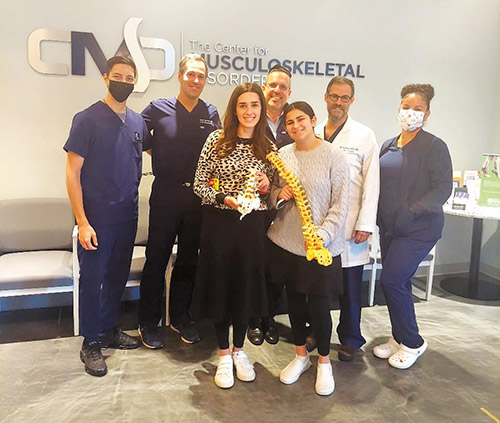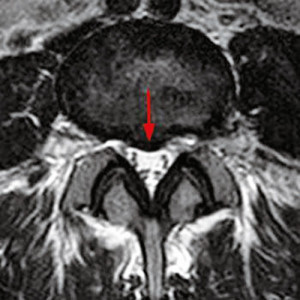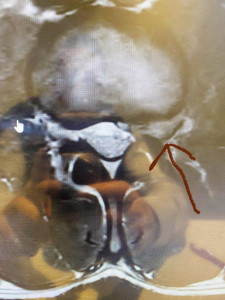
(Courtesy of CMD) As has been previously reported, lumbar disc herniation, or sciatica, is one of the most common spinal conditions confronting the general population. At some point in time, most people between the ages of 30 and 70 will experience a sciatica, in which the lumbar shock absorber, the disc, protrudes or bulges out to pinch on a nerve. This usually happens after some degree of twist, turn, or light trauma, but very often without any particular triggering event. Most of these herniations lead to a central or slightly lateral disc herniation, which will affect either one leg or the other, depending on whether it is right- or left-sided.
Every so often, though, a disc bulges or blasts out from a very far lateral standpoint, which will directly impact on either a right- or left-sided nerve in a very severe way. This is because as the disc bulges out laterally, it hits the nerve as well as the surrounding bone and membrane, which leads to a very tight surface and volume for the nerve, resulting in severe pain. In contrast to a standard lumbar disc herniation or sciatica, this will usually not respond to conservative measures such as physical therapy, medications, and/or epidural injections.

We recently had one such case of this uncommon occurrence in a 38-year-old body builder who, after a particularly rigorous set of exercises over the period of a month, began having severe pain, numbness and weakness into the left thigh region radiating from his back into his left knee. He came in to see us at the Center for Musculoskeletal Disorders, and we immediately ordered an MRI that showed a very large L2-3 far lateral disc herniation. We attempted an epidural steroid injection to give him some relief, with the understanding that it may not give him the necessary long-term comfort and resolution
Indeed, it did reduce the symptoms, but not enough for this very active gentleman. Soearlier this month he was brought to the Bergenfield Surgical Center. A microscopic tubular approach was used and a small, 1.8 cm incision was made on his back. Then a tube was docked onto his L2-3 left lateral space, and the herniated disc was removed by using microscopic assistance. The patient left the surgery center approximately an hour and one-half after the procedure, with his pain reduced and the wounds healing very well! Photos are enclosed.
Although this type of herniation is uncommon, we are seeing it with greater frequency and, therefore, if indeed you are experiencing particularly severe back pain with pain down the leg, with significant numbness and/or tingling, please do not hesitate to contact us about scheduling an appointment to see either one of our pain management doctors or the spinal doctor. We can help obtain the appropriate x-rays and MRI imaging, and get you back to a functional and enjoyable level!

Don’t hesitate to reach our community liaison, Elianna Kranz at 201-8001274 /ekranz@nynjcmd.com or call the office for an appointment at 201-5103777
Wishing you the best of spinal health. Please stay in touch!
CMD Spinal team










